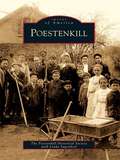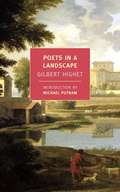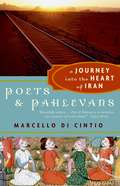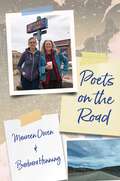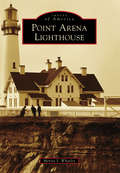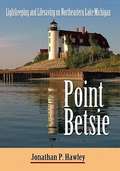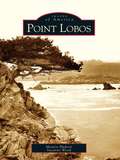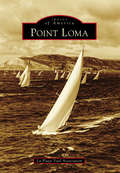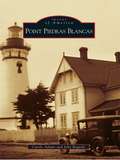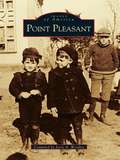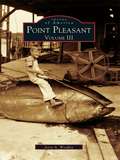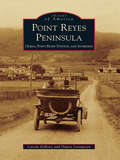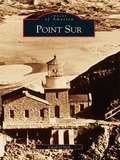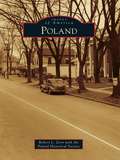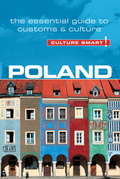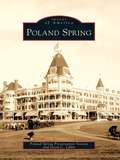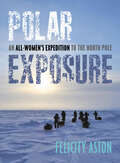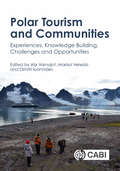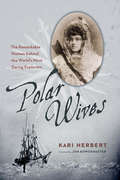- Table View
- List View
Poestenkill
by The Poestenkill Historical Society with Linda SagePoestenkill, formed from the northern half of the township of Sand Lake, was incorporated in 1848 and is the youngest town in Rensselaer County. The name Poestenkill comes from the Dutch and means "foaming creek." The Poestenkill Creek, which runs westerly and empties into the Hudson River, was the center of water-powered industry in the town's early years. When early settlers began arriving and developing the land, Poestenkill was divided into the four hamlets: Poestenkill, East Poestenkill, Ives Corners, and Barberville. Through vintage photographs, Poestenkill provides a glimpse of the town's rich history and draws generations eager to experience the beauty of Poestenkill and the charm of its people.
Poets In A Landscape
by Gilbert HighetGilbert Highet was a legendary teacher at Columbia University, admired both for his scholarship and his charisma as a lecturer. Poets in a Landscape is his delightful exploration of Latin literature and the Italian landscape. As Highet writes in his introduction, “I have endeavored to recall some of the greatest Roman poets by describing the places were they lived, recreating their characters and evoking the essence of their work. ” The poets are Catullus, Vergil, Propertius, Horace, Tibullus, Ovid, and Juvenal. Highet brings them life, setting them in their historical context and locating them in the physical world, while also offering crisp modern translations of the poets’ finest work. The result is an entirely sui generis amalgam of travel writing, biography, criticism, and pure poetry—altogether an unexcelled introduction to the world of the classics.
Poets and Pahlevans: A Journey into the Heart of Iran
by Marcello Di CintioMarcello Di Cintio prepares for his "journey into the heart of Iran" with the utmost diligence. He takes lessons in Farsi, researches Persian poetry and sharpens his wrestling skills by returning to the mat after a gap of some years. Knowing that there is a special relationship between heroic poetry and the various styles of traditional Persian wrestling, he sets out to discover how Iranians "reconcile creativity with combat."From the moment of his arrival in Tehran, the author is overwhelmed by hospitality. He immerses himself in male company in tea houses, conversing while smoking the qalyun or water pipe. Iranian men are only too willing to talk, especially about politics. Confusingly, he is told conflicting statements-that all Iranians love George Bush, that all Iranians hate George Bush; that life was infinitely better under the Shah, that the mullahs swept away the corruption of the Shah's regime and made life better for all.Once out of Tehran, he learns where the traditional forms of wrestling are practised. His path through the country is directed by a search for the variant disciplines and local techniques of wrestling and a need to visit sites and shrines associated with the great Persian poets: Hafez, Ferdosi, Omar Khayyám, Attar, Shahriyar and many others. Everywhere his quest leads him, he discovers that poetry is loved and quoted by everyone from taxi-drivers to students.His engagement with Iranian culture is intimate: he wrestles (sometimes reluctantly) when invited, samples illegal home-brew alcohol, attends a wedding, joins mourners, learns a new way to drink tea and attempts to observe the Ramazan fast, though not a Muslim himself. Though he has inevitable brushes with officialdom, he never feels in danger, even when he hears that a Canadian photo-journalist has apparently been beaten to death in a police cell during the author's visit. The outraged and horrified reaction of those around him to this violent act tightens the already close bond he has formed with the Persians.His greatest frustration is that he is unable to converse freely with Iranian women aware that an important part of his picture of Iran is thus absent. Yet the mosaic of incidents, encounters, vistas, conversations, atmospheres and acutely observed sights, smells and moments creates a detailed impression of a country and society that will challenge most, if not all, preconceptions.From the Hardcover edition.
Poets on the Road
by Maureen Owen Barbara HenningCalling to mind Basho¯&’s late life journeys through the backcountry of Japan, two women poets in a well-worn Honda hit the road for a legendary pilgrimage in a far-flung (pre-pandemic) landscape of American poetry.Although a road trip across North American calls to mind Jack Kerouac&’s youthful meanderings of self-discovery, this reading tour was more in the manner of Basho¯&’s late life journeys through the backcountry of Japan. . . . The road trip was in a sense a pilgrimage of reengagement with their calling as poets, and a chance to reacquaint with like-minded friends, old and new, in a far-flung landscape of American poetry. Venues would include upscale bookstores, coffee houses, museums, legendary used bookstores, botanical gardens, university classrooms, art centers, and artist coops—in short, a unique sampling of poetry environments tracing an arc across the Southern States, the Southwest, and up the West Coast before hooking back to the Rockies. Framed as a personal challenge, the poets hit the road much in the manner of itinerant preachers and musicians, lodging at discount motels, funky hostels, Airbnbs, and with friends along the way. Adding a social media touch, Maureen and Barbara created a blog of their tour so that friends, family, hosts, and fellow poets might also share in their adventure. —from the Introduction by Pat Nolan
Pohnpei, An Island Argosy
by Gene AshbyAll you ever wanted to know about Pohnpei's history, culture, and languages.
Point Arena Lighthouse
by Merita S. WhatleyThe low rumbles of the fog signal and flashing beam of light from the powerful lens have guided mariners away from the perilous waters surrounding Point Arena Lighthouse since 1870. After the great earthquake in 1906 and the rebuilding of the tower in 1908, Point Arena's navigational aids continued to warn ships away from the peninsula off Northern California's Pacific coastline. The original tower was replaced with a concrete cylindrical tower that rises 115 feet from the headland. This became the first lighthouse tower in the United States constructed with materials found to be superior to the stone and masonry lighthouse structures of the past. The new tower, crowned with a nearly 13,000-pound first-order Fresnel lens, sent a beam of light 20 miles out to sea and continued alerting ships of the dangers just offshore.
Point Betsie: Lightkeeping and Lifesaving on Northeastern Lake Michigan
by Jonathan P. HawleyPoint Betsie: Lightkeeping and Lifesaving on Northeastern Lake Michigan is the compelling story of a key Great Lakes lighthouse whose beam has pierced night skies for 150 years. This rich history recounts the efforts of the U. S. Lighthouse Service, the U. S. Life-Saving Service, and the U. S. Coast Guard on Lake Michigan's wreck-strewn northeastern coast, near the treacherous Manitou Passage. Much of Point Betsie's story is told in the accounts of dedicated keepers who served there with their families since 1858. Photographs also chronicle the lighthouse's expanding services through the years and the site's transition from early isolation to today's frequently visited attraction on Lake Michigan's northeastern shore. The author devotes equal attention to the courageous lifesaving crews that served mariners off Point Betsie from 1877 to 1937. Keepers' logs bring to life the heroic rescues from wrecks that surfmen discovered while conducting their lonely night-time beach patrols, and document Point Betsie's central but previously untold role in the area's important maritime and social history. Point Betsie also covers the "laker" fleet's evolution from wooden sailing vessels to massive steamships. Lighthouse operations are detailed, starting with Point Betsie's original oil lamps and then state-of-the-art Fresnel lens, and culminating with the electrically powered, automated beacon that now shines atop this historic and revered tower.
Point Lobos
by Monica Hudson Suzanne WoodFor more than a century the incomparable beauty of Point Lobos has drawn admirers from around the world. The jagged rock outcroppings, driftwood-strewn beaches, and silhouetted cypress trees, twisted grotesquely by the wind, were favorite subjects for photographers Ansel Adams and Edward Weston. Point Lobos is also a favorite playground for seals, sea lions, and otters, and migrating grey whales pass just offshore. Barking sea lions reminded 18th-century Spanish explorers of sea wolves, in their tongue, lobos marinos, and so they named it Point of the Sea Wolves. Now a California State Reserve, Point Lobos draws hundreds of thousands of visitors a year.
Point Loma (Images of America)
by La Playa Trail AssociationFrom the arrival of Juan Rodriguez Cabrillo in 1542 to the current world-class yachtsmen and women, San Diego's beautiful natural harbor hugs the peninsula of Point Loma and boasts a significant past. The strategic location of Point Loma has been home to both military defense and business genius. The fishing fleets of the Chinese and Portuguese communities earned the Roseville area of Point Loma the nickname "Tunaville." Today, Point Loma is one of San Diego's most historic neighborhoods; a destination for culture, fine dining, and sportfishing; and host to important military bases. Visitors from around the world enjoy spectacular vistas and waterfront views of the Pacific Ocean, harbor, city, and islands and mountains of Mexico from atop the peninsula at Cabrillo National Monument and Fort Rosecrans National Cemetery.
Point Piedras Blancas (Images of America)
by Carole Adams John H. BogackiFor thousands of years, Point Piedras Blancas, located along the central coast of California, has attracted people to its rocky, windswept shores. In ancient times, it was used by Native American cultures. Since 1875, it has been the site of a First Order Lighthouse, warning ships to steer clear of its rocky shoals, a duty it continues to fulfill. Although the years have not been kind to this stunning area nor to the lighthouse, new life is being breathed into it by a partnership of enthusiastic community volunteers and government agencies. Their common goal is to restore this magnificent site to its original state while reintroducing the natural environment that was almost obliterated during the past four decades.
Point Pleasant (Images of America)
by Jerry A. WoolleySince the development of photography in the midnineteenth century, the camera has been used as a tool of both discovery and preservation. Photographs bring alive our image of the past, and can open a floodgate of memories and nostalgia or inspire curiosity and a sense of history. Point Pleasant and Point Pleasant Beach have always been two of New Jersey's most dynamic coastal communities. The scenic beauty and simple charm of the area remains undisturbed today, and it is easy to see why it has been a popular tourist destination for more than two centuries. The last one hundred years have also seen the formation and development of several important industries in the region, including shipbuilding and commercial fishing. This combination of business and recreation, of modern industry and Old World charm, is why Point Pleasant and Point Pleasant Beach remain two of the most vivacious and magnetic communities on the coast of New Jersey.
Point Pleasant: Volume III (Images of America)
by Jerry A. WooleyPoint Pleasant Volume I and Volume II have captivated audiences, and now, in this new addition to the Images of America series, author Jerry Woolley offers us a third volume of images to help us connect with our past. In Point Pleasant Volume III, we are invited to take a stroll down memory lane and see the area's residents at work and at play, boating and fishing, and simply relaxing on the beach. Also featured within these pages are a variety of snapshots of the places and events that have given this community its Old World familiarity. Its no wonder that Point Pleasant and Point Pleasant Beach have been popular tourist destinations for more than two centuries.
Point Reyes Complete Guide
by Jessica LageOnly 30 miles from San Francisco, Point Reyes National Seashore attracts admirers year-round to its forests, wetlands, and beaches. Visitors come to this tranquil place to hike, camp, backpack, bike, kayak, horseback ride, picnic, fish, and nature-watch. This invaluable resource gives detailed information on the trails, roads, camps, and and beaches within the Seashore, plus surrounding parks and preserves. Point Reyes: The Complete Guide to the National Seashore & Surrounding Area has much more than coverage of all the popular recreational activities and hiking trails.
Point Reyes Peninsula: Olema, Point Reyes Station, and Inverness
by Dewey Livingston Carola DerooyThe Point Reyes Peninsula has a rich history encompassing thriving Native American settlements, visits by Francis Drake and Spanish explorers, dramatic shipwrecks, Mexican rancheros, famous dairy farms, railroads, and one of the country's most spectacular lighthouses. These historical facets spawned the three small towns of Olema, Point Reyes Station, and Inverness; each is unique with its own distinctive foundations. Most of the land is now within Point Reyes National Seashore, a refuge created during the Kennedy administration and now one of the more popular destinations on the California coast. The unique geography of the forest, bay, and ocean environments and the abundant wildlife in Point Reyes offers fine scenery, diverse recreational opportunities, and good food and lodging, while the towns retain their old-time character.
Point Sur (Images of America)
by Carol O’neilPoint Sur Lightstation was carved out of solid volcanic rock more than a century ago. When the light was turned on in 1889, no towns or roads were nearby to support the four families that lived atop the giant "moro" rock located just offshore in Big Sur, California. These vintage images tell the story of Pt. Sur Lightstation with its state-of-the-art lighthouse and fog signal system, and the lightkeepers and their families who kept it operating until 1974. The remote location and treacherous coast were constant adversaries. Today, Pt. Sur's lighthouse is automated. The vacant lightstation buildings are a ghost town that reminds us of our proud maritime heritage and the hearty souls who helped light the way.
Poland (Images of America)
by Poland Historical Society Robert L. ZornPoland Township was the first township to be chartered in the Connecticut Western Reserve and was settled by Connecticut pioneers. Jonathan Fowler founded the township and owned an inn near Yellow Creek. This building still stands and is Poland's oldest structure. An important stagecoach stop on the main highway between Cleveland and Pittsburgh, Poland's population soared in the early 1800s. The first blast furnace west of the Alleghenies was built here, and William McGuffey, of the famous McGuffey readers, taught school in Poland before going on to national fame. Poland's education legacy did not stop there. Poland's College Street was home to eight colleges at one time, including the Poland Academy, Poland Seminary, Poland Female College, Poland Law School, and the Poland Medical College. William McKinley, the 25th president of the United States, was a graduate of the Poland Academy and Senator, and later Ambassador William Calhoun graduated from the Poland Seminary. Poland today maintains a quaint New England atmosphere, showing its colonial heritage.
Poland - Culture Smart!
by Greg AllenCulture Smart! provides essential information on attitudes, beliefs and behavior in different countries, ensuring that you arrive at your destination aware of basic manners, common courtesies, and sensitive issues. These concise guides tell you what to expect, how to behave, and how to establish a rapport with your hosts. This inside knowledge will enable you to steer clear of embarrassing gaffes and mistakes, feel confident in unfamiliar situations, and develop trust, friendships, and successful business relationships.Culture Smart! offers illuminating insights into the culture and society of a particular country. It will help you to turn your visit-whether on business or for pleasure-into a memorable and enriching experience. Contents include* customs, values, and traditions* historical, religious, and political background* life at home* leisure, social, and cultural life* eating and drinking* do's, don'ts, and taboos* business practices* communication, spoken and unspoken"Culture Smart has come to the rescue of hapless travellers." Sunday Times Travel"... the perfect introduction to the weird, wonderful and downright odd quirks and customs of various countries." Global Travel"...full of fascinating-as well as common-sense-tips to help you avoid embarrassing faux pas." Observer"...as useful as they are entertaining." Easyjet Magazine"...offer glimpses into the psyche of a faraway world." New York Times
Poland Spring (Images of America)
by Jason C. Libby Poland Spring Preservation SocietyIn 1794, Jabez Ricker traded his land in Alfred to the local Shaker community for property in present-day Poland. Shortly after his arrival, travelers came looking for a place to stay, and the Ricker family began its first inn. In 1844, Hiram Ricker, a grandson of Jabez, discovered the curative powers of the mineral spring on the property and began to share the water with family and friends. Within another half century, sales of the water prompted the building of the Poland Spring House, a summer hotel that eventually had more than 500 rooms and the first golf course at a resort in the country; the purchase of the Maine State Building from the 1893 World's Columbian Exposition in Chicago; and many other ingenious and trend-setting innovations.
Polar Exposure: An All-Women's Expedition to the North Pole
by Felicity AstonThis inspiring account of a diverse all-women&’s expedition to the North Pole reveals the highs and lows of record-breaking, modern-day exploration.&“A wonderful collaboration both on the Arctic ice and onto the page. Each team members voice arises to offer a view beyond the physical giving us the essence of a unique adventure.&” Ann Bancroft, first woman to reach the North Pole and coauthor of No Horizon Is So Far: Two Women and Their Historic Journey across AntarcticaWhen British Explorer Felicity Aston put out an open call for women with little to no experience willing to brave the elements on an expedition to the North Pole, she was stunned to have over 1000 applicants. After narrowing it down to ten women from ten different countries—some of whom had never seen snow before—the team spent the next two years training for this unique opportunity.Each member of the team tells part of the story in her own words, chronicling their grueling preparation in Iceland and Oman, the anticipation for the journey, and the terrifying conditions of the Arctic. Set against a backdrop of Arctic pack ice that is thinner, newer, and less stable than ever before due to climate change—the team face the realities of hungry polar bears, extreme temperatures, and the possibility that anything and everything could go wrong at any moment.Aston beautifully weaves each woman&’s account into the greater expedition narrative, reminding readers of the teamwork needed to complete such a feat. Over 60 stunning photographs illustrate the journey, illuminating the breathtaking landscape along with the joy, pain, and determination of these ten women.Polar Exposure is a powerful celebration of the perseverance of women in science, sports, and exploration that sheds light on all that it takes to reach the top of the world.
Polar Region Explorers 2-Book Bundle: River Rough, River Smooth / Arctic Naturalist
by Anthony DaltonPresenting a special 2-book bundle of Anthony Dalton’s outstanding writing on Canada's polar regions, their history, and their greatest explorers. “Dalton does an excellent job … a very enjoyable read.”— Bios Newsletter Includes: River Rough, River Smooth Manitoba’s Hayes River runs over 600 km, from Norway House to Hudson Bay. Traditionally used for transport and hunting by the indigenous Cree, it became a major fur trade route from the 17th to 19th centuries. This is the account of the author’s journey on the Hayes in the company of modern-day voyageurs reliving the past. Arctic Naturalist J. Dewey Soper was the last of the great pioneer naturalists in Canada, and spent many years in the Arctic, where he discovered the breeding grounds of the blue goose and charted the final unknown region of Baffin Islands coastline.
Polar Tourism
by John Snyder Bernard StonehouseTourism throughout the world raises environmental issues that are often concerned with conflicting rights and responsibilities: the inherent right of mankind to travel, the no-less inherent right of indigenous people to guard their environmental heritage, and the responsibility of governments - local, national or (in the unique case of Antarctica) international - to protect environments over which they exercise stewardship. Additionally, the presence of international commercial enterprises, especially marine and other mass transport modes, represent unique governance challenges. This book deals mainly with environmental issues and the management implications arising from polar tourism, one of the fastest-growing sectors of world tourism. However, many of the issues discussed here arise no less urgently in temperate and tropical wilderness areas, and indeed in any region where sensitive environments are subjected to mass tourism. The principles and guidelines discussed here are of interest and practical use in tourism studies generally.
Polar Tourism and Communities: Experiences, Knowledge Building, Challenges and Opportunities
by Alix Varnajot, Marisol Vereda & Dimitri IoannidesPrior to the outbreak of the coronavirus pandemic in 2020, the Arctic and Antarctic regions were experiencing significant growth in tourist arrivals. In the aftermath of this global crisis, the tourism industry has rebounded and the number of tourists visiting the polar regions is expected to keep growing significantly in the coming years. Remote regions are increasingly accessible as tourism actors develop technologies, diversify activities and itineraries, and climate change worsens. In the Arctic, tourism now takes place year-round through various modalities, ranging from exclusive icebreaker expeditions to the North Pole to mass tourism practices in several destinations such as Rovaniemi, Reykjavik, Longyearbyen or Skagway, wherein tourism not only brings opportunities, but also new challenges to local communities. Meanwhile, gateway cities to Antarctica such as Ushuaia and its inhabitants are set to recover from the severe adverse effects due to the virtual standstill of tourism in the region. This book fills the gap in literature on polar tourism and communities. Through several examples encompassing the Arctic and Antarctica, various chapters examine how both the tourism industry and various communities impact and influence each other from economic, sociocultural, political and environmental perspectives. The contents provide a general perspective regarding polar tourism and chapters focusing on challenges and/or experiences of the communities that are related to tourism in the polar regions and delivers: · Exploration of the complex interactions between polar tourism and local communities · Coverage of a broad range of topics including safety, environmental care, increase in the number of visitors, and the pursuit of new experiences at the farthest extremes of the world. Overall, this book provides a unique and timely analysis of the complex interactions between polar tourism and local communities and could be of interest to advanced-level students and researchers in tourism studies and polar geographies.
Polar Wives: The Remarkable Women behind the World's Most Daring Explorers
by Jon Bowermaster Kari HerbertPolar explorers were the superstars of the "heroic age" of exploration, a period spanning the Victorian and Edwardian eras. In this engaging book, author Kari Herbert explores the unpredictable, often heartbreaking lives of seven remarkable women who married world-famous polar explorers.As the daughter of a pioneering polar explorer, Herbert brings a unique perspective to these stories of polar exploration. In her portraits of the gifted sculptor Kathleen Scott; eccentric traveller Jane Franklin; spirited poet Eleanor Anne Franklin; Jo Peary, the first white woman to travel and give birth in the High Arctic; talented and determined Emily Shackleton; Norwegian singer Eva Nansen; and her own mother, adventurer Marie Herbert, Karie Herbert blends deeply personal accounts of longing, betrayal, and hope with stories of peril and adventure.Herbert illuminates the essential role the women played in supporting, publicizing, defending, and even financing their husbands' expeditions. She follows these "polar wives" not only to the polar wastelands but through wartorn Macedonia, the lawless outback of Australia, and the plague-riddled ancient cities of the Holy Land.With extracts from previously unpublished historic journals and letters, Polar Wives brings together for the first time, the compelling stories of seven adventurous women.
Polaris
by Michael NorthropA crew of children must pilot a ship across unfamiliar seas while a strange creature lurks belowdecks in this fast-paced survival story from New York Times bestselling author Michael Northrop.Alone at sea, with only the stars to guide them...The proud sailing ship Polaris is on a mission to explore new lands, and its crew is eager to bring their discoveries back home. But when half the landing party fails to return from the Amazon jungle, the tensions lead to a bloody mutiny. The remaining adults abandon ship, leaving behind a cabin boy, a botanist's assistant, and a handful of deckhands -- none of them older than twelve. Troubled by whispers of a strange tropical illness and rumors of a wild beast lurking onshore, the young sailors are desperate to steer the vessel to safety. When one of their own already missing and a strange smell drifting up from below deck, the novice crew begins to suspect that someone -- or something -- else is onboard. Having steeled themselves for the treacherous journey home, they now have more to fear than the raging waters of the Atlantic...
Political Ecology and Tourism (Routledge Studies in Political Ecology)
by Jarkko Saarinen Sanjay NepalPolitical ecology explicitly addresses the relations between the social and the natural, arguing that social and environmental conditions are deeply and inextricably linked. Its emphasis on the material state of nature as the outcome of political processes, as well as the construction and understanding of nature itself as political is greatly relevant to tourism. Very few tourism scholars have used political ecology as a lens to examine tourism-centric natural resource management issues. This book brings together experts in the field, with a foreword from Piers Blaikie, to provide a global exploration of the application of political ecology to tourism. It addresses the underlying issues of power, ownership, and policies that determine the ways in which tourism development decisions are made and implemented. Furthermore, contributions document the complex array of relationships between tourism stakeholders, including indigenous communities, and multiple scales of potential conflicts and compromises. This groundbreaking book covers 15 contributions organized around four cross-cutting themes of communities and livelihoods; class, representation, and power; dispossession and displacement; and, environmental justice and community empowerment. This book will be of great interest to students and scholars in tourism, geography, anthropology, sociology, environmental studies, and natural resources management.
